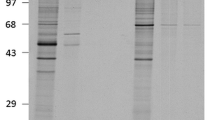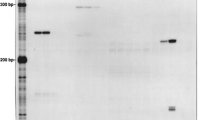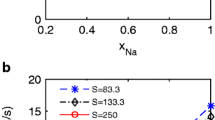Summary
Using squid giant axon, an experimental survey was performed on restoration of the membrane excitability which had been partially suppressed. Among reagents examined, a combination of 400mm KF, 50 μm tyrosine, 1mm ATP, 1mm Mg ions and 5 μm cAMP was found to induce the restoration of the excitability to a large extent. Further addition of a small amount of either porcine brain microtubule proteins or the squid axoplasm was found to support complete restoration. The experiments suggest that tubulin-tyrosine ligase contained in the porcine brain microtubule protein fraction or the squid axoplasm maintains the coupling between cytoskeletal structures and the plasma membrane.
Similar content being viewed by others
References
Barra, H.S., Arce, C.A., Rodriguez, J.A., Caputto, R., 1974. Some common properties of the protein that incorporates tyrosine as a single unit and the microtubule proteins.Biochem. Biophys. Res. Commun. 60:1384
Deanin, G.G., Gordon, M.W. 1976. The distribution of tyrosyltubulin ligase in brain and other tissues.Biochem. Biophys. Res. Commun. 71:676
Guthrow, C.E., Jr., Allen, J.E., Rasmussen, H. 1972. Phosphorylation of an endogenous membrane protein by an endogenous membrane-associated cyclic adenosine 3′, 5′-monophosphate-dependent protein kinase in human erythrocyte ghosts.J. Biol. Chem. 247:8145
Kobayashi, T., Shimizu, T. 1976. Roles of nucleoside triphosphates in microtubule assembly.J. Biochem. (Tokyo) 79:1357
Matsumoto, G., Sakai, H. 1979. Microtubules inside the plasma membrane of squid giant axons and their possible physiological function.J. Membrane Biol. 50:1
Miyamoto, E., Petzold, G.L., Kuo, F.J., Greengard, P. 1973. Dissociation and activation of adenosine 3′, 5′-monophosphate-dependent and guanosine 3′, 5′-monophosphate-dependent protein kinases by cyclic nucleotides and by substrate proteins.J. Biol. Chem. 248:179
Murofushi, H. 1974. Protein kinases in Tetrahymena cilia. II. Partial purification and characterization of adenosine 3′, 5′-monophosphate-dependent and guanosine 3′, 5′-monophosphate-dependent protein kinases.Biochim. Biophys. Acta 370:130
Pant, H.C., Shecket, G., Gainer, H., Lasek, R.J. 1978. Neurofilament protein is phosphorylated in the squid giant axon.J. Cell Biol. 78:R23
Raybin, D., Flavin, M., 1975. An enzyme tyrosylating α-tubulin and its role in microtubule assembly.Biochem. Biophys. Res. Commun. 65:1088
Sakai, H., Matsumoto, G. 1978. Tubulin and other proteins from squid giant axon.J. Biochem. (Tokyo) 83:1413
Steiner, M., 1978. 3′, 5′-cyclic AMP binds to and promotes polymerization on platelet tubulin.Nature (London) 272:834
Tasaki, I., Singer, I., Takenaka, T. 1965. Effects of internal and external ionic environment on excitability of squid giant axon, A macromolecular approach.J. Gen. Physiol. 48:1095
Author information
Authors and Affiliations
Rights and permissions
About this article
Cite this article
Matsumoto, G., Sakai, H. Restoration of membrane excitability of squid giant axons by reagents activating tyrosine-tubulin ligase. J. Membrain Biol. 50, 15–22 (1979). https://doi.org/10.1007/BF01868785
Received:
Revised:
Issue Date:
DOI: https://doi.org/10.1007/BF01868785




